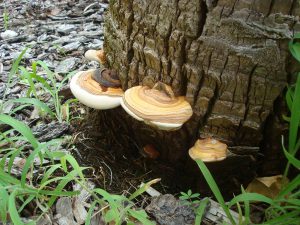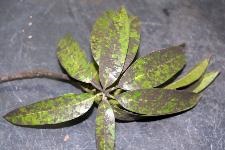
Fungi of all sorts are common in Florida’s warm wet climate. We notice them most when they decide to cause problems such as black spot on roses, brown spots in our lawn, spots on leaves or grass blades, sooty mold on many of our citrus and ornamentals. Healthy lawns and plants are less susceptible to fungal infection. Fungi are primitive plants that do not contain chlorophyll and cannot make sugars as green plants do. They take nourishment from the plants on which they live. Their structure is simple; most fungi are composed of a network of threads, which are sometimes bundled into cords. These threads and cords are called mycelium and make up the body of fungus. They are most easily seen as the fragile white threads that form under rotting leaves. Fungi have a major place in the natural order, they recycle dead plant matter into simpler compounds for reuse in the soil. They are responsible for large portion of plant decay that happens in nature, most of these processes are beneficial and harmless to us and our landscapes.
Signs and Symptoms

When fungal problems arise, we often notice signs of disease similar to other landscape problems such as bacterial and viral pathogens, insect pests, and even physical factors such as overwatering. Fungal diseases can be spread in soil from transplants, by splashing water, or by airborne spores. Some symptoms of fungal diseases include pale patches on leaves, chlorosis (yellowing of leaves), specifically round spots or irregular yellow-green spots that darken with time, decayed spots or sections on leaves, or rust colored spots. In the lawn, this can look like large brown patches or spots on blades of grass.
Many of our landscape plants, potted plants, citrus and palms in particular are subject to root rot fungal diseases which are usually fatal. These fungal pathogens often occur naturally in the soil. One example is Ganoderma Butt Rot of palms which is caused by the fungus Ganoderma zonatum (https://edis.ifas.ufl.edu/pp100). This fungus degrades the lignin in the lower 4–5 feet of the trunk but does not cause a soft rot, so the trunk seems hard.
Prevention and Control
- Buy disease resistant cultivars and plant for diversity in your landscape.
- Water properly. Do not let the irrigation sprays hit your plants foliage, particularly roses. Don’t over water. Water your lawn thoroughly with three fourths of an inch of water twice per week during dry periods of the summer and no more than once per week during the winter. If you have had plenty of rain, turnoff your sprinklers entirely. Water your lawns early in the morning, just before dawn. Watering in the late afternoon or evenings leaves the water sit on the blades until it evaporates the following morning. These wet conditions encourage fungal organisms to develop. When watering plants by hand, avoid wetting the leaves. Apply water on the ground where the roots can absorb it.
- Cleanup all diseased leaves from the plant and the ground and dispose of them.
- When pruning, sterilize your pruning shears with rubbing alcohol or a 10% bleach solution between cuts and before going to another plant to minimize the spread of any diseases.
- Black sooty mold, a black coating on the leaves, is caused by piercing/ sucking insects such as aphids, mealy bugs, scales and thrips. They secrete a sugary waste which promotes the growth of the black mold. Treat with horticultural oils, such as neem oil, or insecticidal soap 3-4 times at 7-10 day intervals.
- When planting, space your plants far enough apart to encourage good air flow and circulation. Fungal diseases thrive in hot, damp areas with poor air circulation. The better the air circulation, the faster the plants will dry after rain or watering.
- There are many commercial fungicides available to the public, many of them work best as preventatives rather than curatives. Follow the label instructions
- Common fungi that affect our lawns include Anthracnose, Brown Patch or Large Patch, Dollar spot, Gray Leaf Spot, Helminthosporium Leaf Spot, Pythium Root Rot, Rhizoctonia Sheath blight, Rust and Take-All root rot. They can be treated with commercially available fungicides, but the best solution is a healthy lawn and good watering practices.
For problem identification, bring a 6 inch x 6 inch piece of the lawn just outside the dead area, roots and all, to your County Extension Service or submit a sample to the Rapid Turfgrass Diagnostic Service http://turf.ufl.edu/rapiddiag.shtml
 0
0
